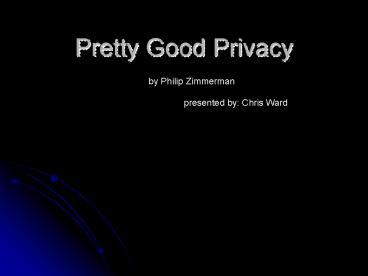Pretty Good Privacy - PowerPoint PPT Presentation
Title:
Pretty Good Privacy
Description:
a non-proprietary protocol for the secure exchange of information between individuals ... secrecy: for hiding illegal, unethical, or immoral activity ... – PowerPoint PPT presentation
Number of Views:60
Avg rating:3.0/5.0
Title: Pretty Good Privacy
1
Pretty Good Privacy
by Philip Zimmerman
presented by Chris Ward
2
What is PGP?
- a non-proprietary protocol for the secure
exchange of information between individuals - a free, open-source program implementing this
protocol
3
Why do you need PGP?
- privacy for protecting personal information
- secrecy for hiding illegal, unethical, or
immoral activity - you dont need it you have nothing to protect or
hide
4
Why should you know about PGP?
- It uses tools that are essential to all forms of
secure communication. - public-key cryptography
- private-key cryptography
- message digests
- digital signatures
5
Why should you know about PGP?
- It uses tools to provide all aspects of secure
communication. - privacy (private-key cryptography)
- integrity (message digests)
- authentication (digital signature)
- non-repudiation (digital signature message
digest)
6
In this presentation I will
- introduce the tools used by PGP
- describe how each tool can be used to provide
some aspect(s) of secure communication - show how PGP combines all of these tools to
facilitate the secure exchange of information
between individuals
7
Tool 1 Private-Key Cryptography
- two parties share a single secret key
- an encryption scheme encrypts/decrypts
information according to the value of the key - good encryption algorithm most efficient attack
is not significantly better than brute force
(guessing each possible key) - Examples DES, Triple DES, AES
8
Privacy with Private-Key Cryptography
- Alice and Bob share a secret key Ks
- Alice composes a message m in plaintext
- She encrypts it with the secret key Ksm
- She sends Ksm to Bob
- How did Alice and Bob agree on Ks ?
9
Tool 2 Public-Key Cryptography
- Each party maintains a key pair (Kpublic,
Kprivate). - If a message is encrypted with Kpublic, it can
only be decrypted with Kprivate. - If a message is encrypted with Kprivate, it can
only be decrypted with Kpublic. - good encryption algorithm private key cannot be
feasibly computed from its corresponding public
key. - Examples RSA, ElGamal
10
Convenient Key Agreement with Public-Key
Cryptography
- provides one answer to How did Alice and Bob
agree on Ks ? - Alice generates a random key and encrypts it
using Bobs public key KBOB-PUBLICKs - Only Bob has KBOB-PRIVATE, so only Bob can
decrypt the secret key. - Alice and Bob no share a secret. Or do they?
- How does Bob know that the message really came
from Alice?.
11
Authentication and Integrity with Public-Key
Cryptography
- Before, Alice sent KBOB-PUBLICKs
- She could send KBOB-PUBLICKs, KALICE-PRIVATEKs
- As before, only Bob can decrypt the information
- Now, Bob can use KALICE-PUBLIC to decrypt
KALICE-PRIVATEKs - If the result is Ks then Bob knows that the key
was sent by Alice and that the key has not been
altered in transmission. - This is just an example to illustrate a digital
signature. - Is there a more efficient way to prove message
integrity than by copying the whole thing?
12
Tool 3 Message Digests
- For a message m, apply a hash function H which
yields a fixed-length message digest H(m) (also
called a digital fingerprint). - good hash function easy to compute and
infeasible to compute m given H(m) - Examples SHA-1, MD5
13
Tool 4 Digital Signature (using message digest)
- Alice composes a message m to Bob.
- She computes H(m) and encrypts it with her
private key. - She sends (m, KALICE-PRIVATE H(m)) to Bob.
- Bob, or anyone, computes H(m), and compares it to
the result of decrypting KALICE-PRIVATE H(m)
with Alices public key. - If they are the same, authentication and
integrity have been proven.
14
Sending secure information with PGP
- Alice composes message m for Bob
- generates a random session key Ks
- encrypts m Ksm ( AESENCRYPT(Ks, m))
- encrypts Ks with Bobs public key
KBOB-PUBLICKs - computes the message digest H(m)
- encrypts H(m) with her private key
KALICE-PRIVATEH(m) - sends this (Ksm, KBOB-PUBLICKs,
KALICE-PRIVATEH(m))
15
Receiving Secure Information with PGP
- Bob receives this (Ksm, KBOB-PUBLICKs,
KALICE-PRIVATEH(m)) - decrypts KBOB-PUBLICKs using his private key,
yielding Ks - decrypts Ksm using Ks, yielding m
- computes H(m) using message digest algorithm H
- decrypts KALICE-PRIVATEH(m) using KALICE-PUBLIC
yielding H(m) - compares H(m) to H(m)
16
Summary
- PGP combines the use of several tools
- public-key cryptography, private-key
cryptography, - message digests
- to provide all of the elements necessary for
secure communication - privacy, integrity, authentication,
non-repudiation
17
Other Stuff
- Can you trust that the public key you are using
really belongs to the intended recipient? - Fake public keys
- Authentication by trusted third party































